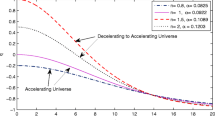Abstract
Recently, the new modified gravity was introduced in which Einstein’s general relativity is developed by adding energy–momentum squared term \({T}_{\mu \nu }{T}^{\mu \nu }\) by coupling constant \(\alpha \). As result, the relevant field equations are different from usual field equations in Einstein’s general relativity only in the presence of matter sources. Analytical consideration proved that for the non-interaction case, the energy–momentum squared term is not strong and only can describe the non-singular big-bang theory. In this study, this theory is applied to the homogenous and isotropic space–time in the presence of the cosmological constant \(\Lambda \). In this context, we face with three plausible models of dark energy. In the first model, dark energy is presented by cosmological constant, only, and thus, extra terms arise from squared term effects on matter evolution. This case gives no new model of dark energy. As shown in Roshan and Shojai (Phys Rev D 94:044002, 2016), considering the cosmological constant as part of the matter field is not equal to the first scenario in which the cosmological constant plays a geometrical role. Therefore, for the second case, the cosmological constant is investigated as the part of the matter action, and we can assume that dark energy includes two parts, the cosmological constant and the energy–momentum squared term. Modeling this scenario illustrates this theory gives no valuable dark energy for \(\alpha \ne 0\). It reveals the second scenario wherein cosmological constant behaves such as part of matter field gives accelerated expansion Universe only in the absence of energy–momentum squared term. In the last plausible scenario, we may assume dark energy constructed with both parts, geometrical part includes cosmological constant and matter effects arise from the energy–momentum squared term. We have shown that only the last model satisfies observations and presents the quintessence dark energy in which cosmological constant problems are solved. Moreover, it is shown that this model coincides with \(\Lambda \)CDM theory with some small errors in studying theoretical CMB temperature and linear matter power spectrum.








Similar content being viewed by others
Data availability
There are no data associated in the manuscript.
References
E. Poisson, C.M. Will, Gravity: Newtonian, Post-Newtonian, Relativistic (Cambridge University Press, Cambridge, 2014)
A.G. Riess, Nat. Rev. Phys 2, 10–12 (2020)
R. Allahverdi et al., Open J. Astrophys. 4, 133 (2021)
B. Ratra, M.S. Vogeley, Pub. Astron. Soc. Pac. 120, 235 (2008)
A.G. Riess et al., Astron. J. 116, 1009 (1998)
S. Perlmutter et al., Astrophys. J. 517, 565 (1999)
P. de Bernardis et al., Nature 404, 955 (2000)
S. Perlmutter et al., Astrophys. J. 598, 102 (2003)
M. Natsuume, arXiv:gr-qc/0108059
A.V. Frolov, Phys. Rev. Lett. 101, 061103 (2008)
V. Belinski, AIP Conf. Proc. 1205, 17 (2010)
T. Clifton et al., Phys. Reports 513, 1–189 (2012)
G. ’t Hooft, M.J.G. Veltman, Ann. Poincaré Phys. Theor. A 20, 69 (1974)
P.J.E. Peebles, B. Ratra, Rev. Mod. Phys. 75, 559–606 (2003)
T. Padmanabham, Phys. Rep. 380, 235 (2003)
V. Sahni, A. Starobinsky, Int. J. Mod. Phys. D 9, 373 (2000)
K. Bamba et al., Astrophy. Space Sci. 342, 155–228 (2012)
M.J. Mortonson et al., arXiv:1401.0046
A. Joyce et al., Ann. Rev. Nuc. Part. Sci. 66, 95–122 (2016)
A.S. Eddington, The Mathematical Theory of Relativity (Cambridge University Press, Cambridge, 1924)
C.H. Brans, R.H. Dicke, Phys. Rev. 124, 925 (1961)
F.W. Hehl et al., Rev. Mod. Phys. 48, 393 (1976)
A. De Felice, S. Tsujikawa, Living Rev. Rel. 13, 3 (2010)
T.P. Sotiriou, V. Faraoni, Rev. Mod. Phys. 82, 451–497 (2010)
T. Harko et al., Phys. Rev. D 84, 024020 (2011)
E.H. Baffou et al., arXiv:1706.08842
R. Myrzakulov, Euro. Phys. J. C 72(N11), 2203 (2012)
E.N. Saridakis et al., Phys. Rev. D 102, 023525 (2020)
S. Wang et al., Phys. Reports 696, 1–57 (2017)
M. Malekjani et al., MNRAS 464, 1192 (2017)
M. Tavayef et al., Phys. Lett. B 781, 195–200 (2018)
H.R. Fazlollahi, Phys. Dark Univ. 28, 100523 (2020)
M. Roshan, F. Shojai, Phys. Rev. D 94, 044002 (2016)
C.V.R. Board, J.D. Barrow, Phys. Rev. D 96, 123517 (2017)
M. Khodadi et al., Phys. Dark Univ. 36, 101013 (2022)
Bo. Wang et al., ApJ 898, 100 (2020)
N. Aghanim et al., A&A 641, A6 (2020)
Z.H. Zhu, M.K. Fujimoto, X.T. He, Astrophys. J. 603, 365 (2004)
S. Weinberg, Gravitation and Cosmology (Wiley, New York, 1972)
W. Rindler, Relativity: Special, General, and Cosmological, 2nd edn. (Oxford University Press, Oxford, 2006)
Y. Wang et al., Phys. Rev. D 85, 023517 (2012)
C.L. Bennett et al., arXiv:1212.5225
G. Hinshaw et al., arXiv:1212.522
A. Lewis, A. Challinor, http://camb.info
Acknowledgements
The author thanks V. D. Ivashchuk and A. H. Fazlollahi for their helpful cooperation and comments. We also thank dear reviewer for useful comments.
Author information
Authors and Affiliations
Corresponding author
Supplementary Information
Below is the link to the electronic supplementary material.
Rights and permissions
Springer Nature or its licensor (e.g. a society or other partner) holds exclusive rights to this article under a publishing agreement with the author(s) or other rightsholder(s); author self-archiving of the accepted manuscript version of this article is solely governed by the terms of such publishing agreement and applicable law.
About this article
Cite this article
Fazlollahi, H.R. Energy–momentum squared gravity and late-time Universe. Eur. Phys. J. Plus 138, 211 (2023). https://doi.org/10.1140/epjp/s13360-023-03723-w
Received:
Accepted:
Published:
DOI: https://doi.org/10.1140/epjp/s13360-023-03723-w




